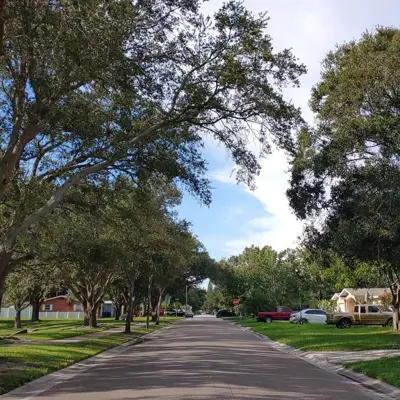Tree Guide
|
Trees in Park Strips Beneath Power Lines |
|
|---|---|
|
Common Name |
Botanical Name |
|
Malus (non-weeping only) 15' or under |
|
|
Laburnum x watereri |
|
|
Crataegus crus-galli "Crusader" |
|
|
Syringa pekinensis (all cultivars) |
|
|
Acer tataricum (all cultivars) |
|
|
Prunus cerasifera (all cultivars) |
|
| Trees in Park Strips 5 Feet or Less Without Power Lines | |
|---|---|
|
Common Name |
Botanical Name |
|
Malus (non-weeping only) |
|
|
Ulmus hybrids (30' or less in width) |
|
|
Ginkgo biloba "Princeton Sentry" |
|
|
Koelreuteria paniculata "Golden Candles" |
|
|
Celtis occidentalis "Prairie Sentinel" |
|
|
Crataegus crus-galli "Inermis" |
|
|
Gleditisia triacanthos (all seedless cultivars) |
|
|
Sophora japonica |
|
|
Syringa reticulata (all cultivars) |
|
|
Acer tartarica (all cultivars) |
|
|
Sorbus aucuparia (all cultivars) |
|
|
Quercus robur fastigiata (all cultivars) |
|
|
Quercus bicolor |
|
|
Quercus macrocarpa (all cultivars) |
|
|
Zelkova serrata Mushashino |
|
|
Trees in Park Strips of 5 to 8 Feet or Larger Without Power Lines |
|
|---|---|
|
Common Name |
Botanical Name |
|
Fagus sylvatica "Dawyck", "Dawyck Purple" or "Red Obelisk" |
|
|
Malus (non-weeping varieties only) |
|
|
Ulmus hybrids (30' or less in width) |
|
|
Ginkgo biloba (all cultivars) |
|
|
Gleditsia triacanthos (all seedless varieties) |
|
|
Parrotia persica |
|
|
Syringa reticulata (all cultivars) |
|
|
Acer miyabei |
|
|
Acer truncatum x Acer platanoides (Crimson, Norwegian, Pacific, Ruby, and Urban) |
|
|
Sorbus aucuparia (all cultivars) |
|
|
Quercus robur fastigiata (all cultivars) |
|
|
Quercus bicolor |
|
|
Quercus macrocarpa |
|
|
Cercis Canadensis |
|
|
Amelanchier laevis "Spring Flurry" |
|
|
Zelkova serrata (all cultivars) |
|
|
Trees in Park Strips 10 Feet or Larger Without Power Lines |
|
|---|---|
|
Common Name |
Botanical Name |
|
Catalpa speciosa |
|
|
Gymnocladus dioica |
|
|
Ulmus hybrids (no restriction on size) |
|
|
Celtis occidentalis |
|
|
Tilia americana Redmond |
|
|
Tilia cordata (all cultivars) |
|
|
Tilia tomentosa (all cultivars) |
|
|
Platanus x acerifolia (all cultivars) |
|
|
Acer miyabei |
|
|
Acer truncatum x Acer platanoides (Crimson, Norwegian, Pacific, Ruby, and Urban) |
|
|
Acer pseudoplatanus |
|
|
Quercus macrocarpa (all cultivars) |
|
|
Quercus muehlenbergii |
|
|
Quercus shumardii |
|
|
Quercus bicolor |
|
|
Liriodendron tulipifera "Emerald City" |
|
|
Cladrastis kentukea (C. lutea) |
|
|
Zelkova serrata (all cultivars except Musashino) |
|
| Conifers Best in Groupings at Entrances to Developments and in Non-Traditional Park Strips at Least 20 Feet Wide | |
|---|---|
|
Common Name |
Botanical Name |
|
Thuja orientalis |
|
|
Cedrus atlantica Glauca |
|
|
Cedrus deodara "Karl Fuchs", "Kashmir", "Shalimar" |
|
|
Chamaecyparis nootkatensis "Pendula" |
|
|
Abies concolor* |
|
|
Pseudotsuga menziesii |
|
|
Calocedrus decurrens |
|
|
Juniperus chinensis |
|
|
Juniperus scopulorum |
|
|
Juniperus osteosperma** |
|
|
Pinus nigra (cultivars for columnar) |
|
|
Pinus leucodermis "Heldrechii" |
|
|
Pinus sylvestris |
|
|
Pinus strobus |
|
|
Pinus flexilis "Vanderwolf's Pyramid" |
|
|
Juniperus virginiana |
|
|
Picea pungens (smaller cultivars)* |
|
* These species do not do well with secondary water
** These have limited availability
|
Trees for Elevations Above 5,000 Feet |
|
|---|---|
|
Common Name |
Botanical Name |
|
Celtis occidentalis |
|
|
Crataegus douglasii |
|
|
Juniperus scopulorum (all cultivars) |
|
|
Acer ginnala (all cultivars) |
|
|
Acer grandidentatum (all cultivars)* |
|
|
Quercus gambelii |
|
|
Pinus aristata |
|
|
Pinus edulis |
|
|
Amelanchier alnifolia or utahensis |
|
|
Amelanchier x grandifolia "Autumn Brilliance" |
|
|
Rhus glabra |
|
|
Picea pungens (all cultivars) |
|
* These species do not do well with secondary water
It is recommended that you have your soil tested to make sure it does not have verticillium wilt. Some trees will survive with this present, but it will kill others, especially maples. In trees, symptoms can appear any time but often start in hot, dry weather. Leaves will be smaller than usual and the margins may brown, looking like they are scorched. Leaves may wilt on some large branches in the crown, or on the entire side of the tree before eventually dying. Another indicator is the tree produces more seeds than usual.
Contact Us
Planning Office
Email
(801) 576-6399

